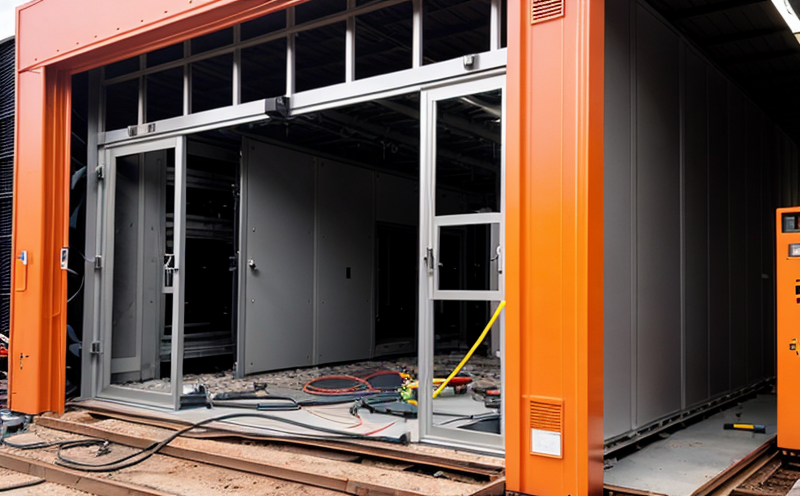IEEE 1188 Thermal Safety Testing of VRLA Batteries in Stationary Applications
The IEEE Standard Standard Test Method for Determination of Thermal Stability of Valve Regulated Lead Acid (VRLA) Batteries, IEEE Std. 1188-2016, is a critical guideline for testing the thermal stability of valve-regulated lead-acid batteries used in stationary applications. This standard ensures that these batteries meet stringent safety and performance criteria under defined thermal stress conditions.
Valve Regulated Lead Acid (VRLA) batteries are widely employed in various stationary applications such as uninterruptible power supplies, energy storage systems, and backup power solutions for telecommunications infrastructure. The primary concern with VRLA batteries is their potential to overheat during operation, leading to thermal runaway conditions which could result in damage or even explosion of the battery.
The IEEE 1188-2016 standard provides a robust framework for conducting thermal safety tests that assess the ability of these batteries to withstand temperature excursions without compromising structural integrity or performance. The testing process involves subjecting the battery to controlled heating conditions, monitoring its behavior, and evaluating the extent of any degradation.
Compliance with this standard is not only essential for ensuring product reliability but also crucial from a safety perspective. Regulatory bodies worldwide recognize the importance of adhering to such standards to protect consumers and infrastructure from potential hazards associated with battery failures.
The testing protocol outlined in IEEE 1188-2016 includes detailed procedures for specimen preparation, equipment setup, and data recording. Specimens must be prepared according to specific dimensions provided within the standard to ensure accurate results. Once ready, the batteries undergo heating cycles at specified temperatures and durations, while being continuously monitored using advanced thermal imaging technology.
Data collected during these tests helps determine whether the battery maintains its structural integrity, electrical performance, and chemical composition throughout the test period. If any signs of failure are detected—such as deformation, leakage, or change in internal resistance—the battery fails the test and would need further investigation into its design or manufacturing process.
By ensuring compliance with IEEE 1188-2016, manufacturers can demonstrate their commitment to producing safe and reliable products. This is particularly important given that stationary applications often involve large numbers of batteries operating in close proximity, making thermal stability a key factor for overall system safety.
Furthermore, adherence to this standard provides third-party verification of product quality, which enhances customer confidence and facilitates smoother market entry into regions with stringent regulatory requirements.
Benefits
The IEEE 1188-2016 thermal safety testing offers numerous benefits to both manufacturers and end-users of VRLA batteries. For manufacturers, it provides a standardized method for quality assurance that can be used internally during development stages as well as externally when seeking third-party certification.
From an end-user perspective, compliance with this standard ensures peace of mind knowing that the product has undergone rigorous testing to meet stringent safety standards. This is especially important in critical infrastructure where uninterrupted power supply is paramount.
The test results also serve as valuable input for continuous improvement efforts aimed at enhancing battery performance and lifespan. By identifying weak points early on, manufacturers can make necessary adjustments before products reach final stages of production or are deployed into real-world environments.
In summary, IEEE 1188-2016 thermal safety testing plays a vital role in safeguarding both people and property by mitigating risks associated with battery failures. It supports reliable operation across various applications while promoting responsible manufacturing practices.
Industry Applications
The IEEE 1188-2016 thermal safety testing is applicable across a wide range of stationary applications where VRLA batteries play a crucial role. These include:
- Uninterruptible Power Supplies (UPS) for data centers and telecom facilities.
- Energy storage systems designed to integrate renewable energy sources into existing power grids.
- Backup power solutions deployed in hospitals, airports, and other critical infrastructure.
- Battery banks used in telecommunications towers to ensure continuous communication services.
In all these applications, reliability and safety are paramount considerations. IEEE 1188-2016 thermal safety testing ensures that the batteries perform consistently under extreme temperature conditions without compromising on either aspect.
Use Cases and Application Examples
The following case studies illustrate how IEEE 1188-2016 thermal safety testing has been applied in real-world scenarios:
Critical Telecom Facility Backup Power System: A major telecommunications company implemented IEEE 1188-2016 compliant tests on its VRLA batteries used for backup power supply at a critical facility. The rigorous testing process identified potential weaknesses that were subsequently addressed, resulting in enhanced reliability and peace of mind for stakeholders.
Renewable Energy Integration Project: An energy provider conducted IEEE 1188-2016 thermal safety tests on VRLA batteries intended for use in a large-scale solar farm's battery storage system. The results demonstrated the batteries' ability to withstand temperature variations, thereby enabling successful integration into the grid.
Medical Facility UPS System: A hospital upgraded its uninterruptible power supply (UPS) using IEEE 1188-2016 compliant VRLA batteries. The thorough testing process reassured staff and patients about the reliability of backup power during routine maintenance or unexpected outages.
These examples highlight how adherence to IEEE 1188-2016 enhances confidence in battery performance, especially when used in demanding environments where uptime is crucial.





